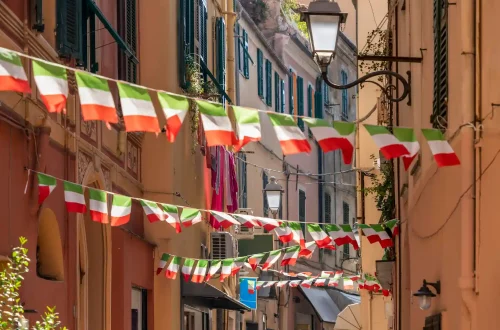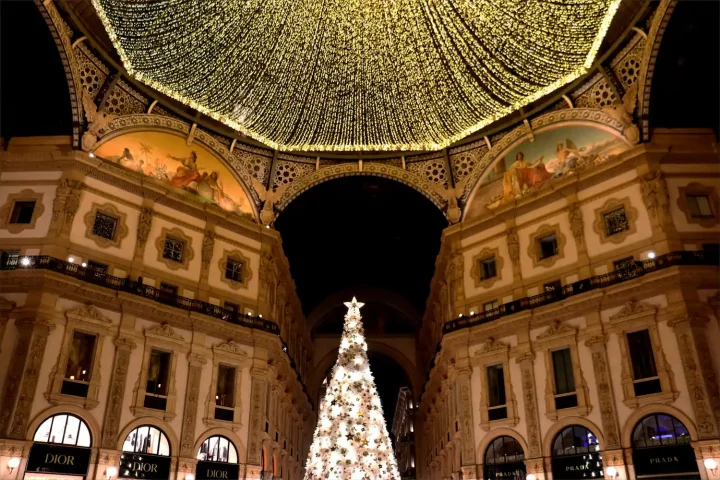Christmas in Italy, or Natale, is a cultural and religious experience that stretches across regions, generations, and centuries. From the solemnity of sacred traditions to the warmth of family gatherings and the indulgence of festive foods, Italian Christmas is a season of joy, reflection, and community.
The rhythm of the season: key dates and celebrations
The Italian Christmas season officially begins on December 8, with the Festa dell’Immacolata Concezione (Feast of the Immaculate Conception). This Catholic holiday honors the Virgin Mary and marks the start of festive decorations, including the setup of nativity scenes and Christmas trees in homes and public squares.
Celebrations continue through December 24, when families gather for the Cenone, a lavish Christmas Eve dinner, and often attend La Messa di Mezzanotte (Midnight Mass). Christmas Day is reserved for family meals and gift exchanges, while December 26, Santo Stefano, is a public holiday for continued festivities.
The season culminates on January 6, with the Epifania (Epiphany), commemorating the visit of the Magi to baby Jesus. This day is also associated with La Befana, a beloved folkloric figure who delivers sweets to children.
Cultural and religious significance
For many Italians, Christmas is a time to reconnect with faith and family. The religious aspect is central, with nativity scenes (presepi) taking precedence over commercial symbols like Santa Claus. Churches host special masses, and towns organize processions and reenactments of the Nativity story.
Yet, Natale is also a celebration of togetherness. Families reunite, often traveling long distances to share meals, exchange gifts, and honor traditions passed down through generations. It’s a season where the sacred and the social intertwine beautifully.
Take advantage of specialized assistance to secure your passport for a borderless future.
Traditions that define Italian christmas
The presepe
The presepe is perhaps the most iconic Italian Christmas tradition. Originating with St. Francis of Assisi in the 13th century, these nativity scenes range from simple figurines to elaborate displays with moving parts, lights, and entire village settings. Naples, especially the Via San Gregorio Armeno, is famous for its handcrafted nativity figures.
Sweet Traditions
No Italian Christmas is complete without panettone and pandoro. Panettone, a Milanese dome-shaped bread filled with raisins and candied fruit, is often served with mascarpone cream. Pandoro, from Verona, is a golden, star-shaped cake dusted with powdered sugar.
On New Year’s Eve, Italians eat lenticchie (lentils), symbolizing prosperity and good luck. Often paired with cotechino (a rich pork sausage), this dish is a must-have for ringing in the new year.
Regional Flavors and Festivities
Italy’s regional diversity shines during the Christmas season. In the north, cities like Bolzano and Trento host enchanting Christmas markets (mercatini di Natale) with Alpine charm, handmade crafts, and mulled wine. The Dolomites offer snow-covered landscapes perfect for winter sports and cozy celebrations.
In the south, religious processions and community events take center stage. In Bari, the Festa di San Nicola on December 6 honors St. Nicholas with parades and church services. Sicily and Calabria feature dramatic nativity reenactments and traditional music.
Central Italy, including Rome and Florence, blends solemn religious observance with festive street life. The Vatican hosts a massive presepe in St. Peter’s Square and a midnight mass led by the Pope, drawing pilgrims from around the world.
Experiencing Christmas in Italy
If you’re planning to spend Christmas in Italy, here are some practical tips:
- Book early: December is a peak travel season, especially in cities with famous markets or religious events.
- Visit christmas markets: Bolzano, Milan, and Florence offer some of the best markets for gifts, food, and festive ambiance.
- Join local traditions: Attend a midnight mass, explore nativity scenes, and try regional holiday dishes.
- Dress warmly: Winters can be chilly, especially in the north. Layer up and enjoy the seasonal charm.
The perks of Italian citizenship
Having Italian citizenship opens doors to deeper cultural experiences. You can stay in Italy indefinitely without worrying about visa restrictions, allowing you to fully immerse yourself in the holiday season and explore regional traditions at your own pace.
Citizenship also grants access to EU healthcare and education, which is especially beneficial for families considering extended stays or relocation. Whether you’re reconnecting with ancestral roots or simply embracing Italian culture, citizenship enhances your ability to live like a local.
Take advantage of specialized assistance to secure your passport for a borderless future.
How U.S. residents can obtain Italian citizenship
For Americans with Italian ancestry, obtaining citizenship is possible through jus sanguinis (right of blood). Here’s what the process typically involves:
- Proof of lineage: You must demonstrate an unbroken line of Italian descent from an Italian grandparent or parent, often through birth, marriage, and death certificates.
- No naturalization: Your Italian ancestor must have been born in Italy and held exclusive Italian citizenship at the time of their death.
- Document translation and legalization: All documents must be translated into Italian and legalized for use in Italy.
For more information on the intricacies of the Italian citizenship process, click here.
The process can take 12 to 24 months. Costs vary but generally range from $2,000 to $5,000, especially if you hire a professional service.
Given the bureaucratic intricacies, working with a specialized consultant or legal advisor is highly recommended. They can help you avoid common pitfalls, ensure your documents are in order, and streamline the application process.






